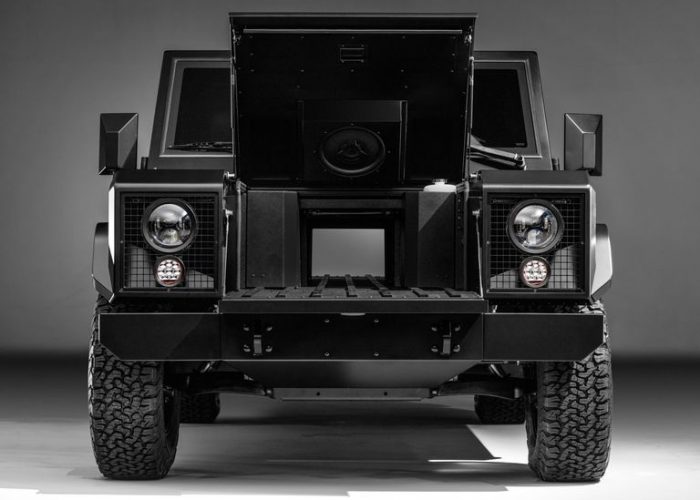The automotive industry’s sudden interest in all-electric pickups may have been surprising initially, but they’ve since offered a few perks that have helped us understand why companies are suddenly so smitten with the concept. When Rivian first showed its pickup in 2018, it came with some interesting storage solutions that were only possible because it doesn’t need to worry about things like a driveshaft tunnel or a crowded engine bay. We wouldn’t call them game changers but they certainly opened the door (literally) for new storage options and we’re beginning to see this take ever-more impressive forms.
Bollinger Motors has recently patented a passthrough gate that allows one to slot exceptionally long cargo all the way through the vehicle. Officially, they’re two separate patents that work in tandem to allow pickup owners a spot to stash up to 16 feet of lumber â or more if one doesn’t mind it hanging out the front and/or back of the vehicle. Just be sure to tie things down so you don’t accidentally create a brake-launched tarmac torpedo.Â
“Passthrough” and “Frunkgate” are two items Bollinger is obviously proud of and they’re supposed to be coming as options for the B1 and B2 once they’ve entered into production. As an EV startup, there’s little reason to assume the brand will adhere to any timetables â especially with the world coming to an end. But the plan is to start building the world’s only heavy-duty pickups that are entirely dependent upon electricity by the end of 2021.
Bollinger has said that the frunk (the empty void where an engine would normally be) provides 8.6 cubic feet of space by itself. However, it’s also capable of accepting items sent through the cabin, just as Passthrough does for the back half of the truck. While this doesn’t end our suspicions that modern EVs lack the kind of energy density that would make towing long-range towing a repeat endeavor, it shows they may be able to make up for it in other ways until the engineers can even the score. The manufacturer also seems to have considered this. CEO Robert Bollinger recently told Car & Driver that he set out to make a pickup that agreed with his farm â and that’s where we think it will excel most.
The Bollinger EVs are priced and designed to give the Mercedes-Benz G-Class (and eventually Cybertruck) some company on L.A.’s Rodeo Drive. But they’ll probably be more at home among the oddly high number of off-roaders modified with ICON parts found in trendy New York neighborhoods. Still, it seems ideal for doing jobs around your country estate â which those buying a $125,000 electric pickup can easily afford.
Nothing about Bollinger’s aerodynamics shout “put me on a highway.” Instead, they seem to be asking you to run the truck up a grassy hill â fully loaded at modest speeds. Following its hard day of work, the Bollinger can then be charged overnight at home and made ready for the morning jaunt to the great breakfast spot the spouse keeps talking about.
“We started with a clean sheet of paper and [read more] how can we make trucks better? And what if we were just to land on Planet Earth and come up with our own idea of what a truck should do? What would be in it? So we threw all that kind of stuff into this truck. And a whole new layout. So this patent reflects that,” Bollinger explained to Car & Driver.
Structurally similar, both the B2 and B1 carry the same six-figure price tag and use the brand’s “e-chassis” skateboard platform. The B1 just happens to use an enclosed SUV-style body while the B2 serves as a slightly longer pickup. Bollinger said their shared dual-motor system puts out 614 horsepower and 668 pound-feet of instantaneous torque and claimed their approach, departure and break-over angles will all surpass that of the Jeep Wrangler. Payload is estimated to be roughly 5,200 pounds, with a towing capacity of 7,500 pounds.
That’s not quite what one would expect from an HD pickup but at least makes it useful enough to get some jobs done that the Chevrolet Colorado cannot. We’re just wondering how the range is impacted when working with a full load.
[Images:Â Bollinger Motors]
Bollinger Patents Passthrough Cargo Gate for Pickup/SUV


